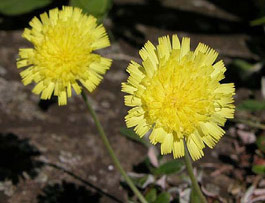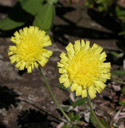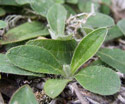Mouse-Ear Hawkweed
Hieracium pilosella • Class B |
||
| Family Name: | Asteraceae family (ass-ter-AY-see-ee) | |
| Common: | Aster, daisy, or sunflower family | |
| Genus: |
Hieracium (hi-er-uh-KEE-um) Meaning: From the Greek meaning a hawk, referring to belief that hawks fed on the plant to strengthen eyesight |
|
| Species: |
pilosella (pil-oh-SEL-uh) Meaning: Hairy, small hairs |
|
| Description: |
The plant has a basal rosette of narrow, pointed leaves, with a single, upright yellow flower head that resembles a dandelion. The leaf tops are covered in bristly hairs while the undersides have a soft wooly feel. Plants contain a milky juice. The flowering stalks are covered in short bristly hairs and are usually leafless, but occasionally have 1 or 2 small leaves and stand about 3 to 10 inches tall. Its seeds are purplish black, short, columnar with many white bristles (pappus) on one end of the seed which act like a parachute as the wind distributes the seed. |
| Why Is it a Noxious Plant? |
It is not allelopathic, but its creeping growth fills in the gaps between other plants forming mats of rosettes which prevents other plants from establishing seedlings. |
| Where Does it Grow? |
Mouse ear hawkweed infests forests, pastures, meadows, wetlands and suburban lawns and is especially invasive on infertile, shallow or coarse soils in regions of relatively high rainfall. It does not tolerate shade. |
| Facts: |
This noxious weed out competes pasture and native plants. As desirable forage plants are replaced by the somewhat unpalatable hawkweed, biodiversity decreases. |
| Control Options: |
Early detection and eradication are important to prevent the spread of hawkweed. Prevent new infestations by maintaining good ground cover with perennial grasses and clover.
|
| More Information: |
Download our Flyer or visit Washington State Noxious Weed Control Board Here. Photo by Leo Michels
|
| More Pictures: |




